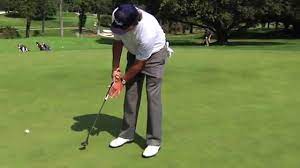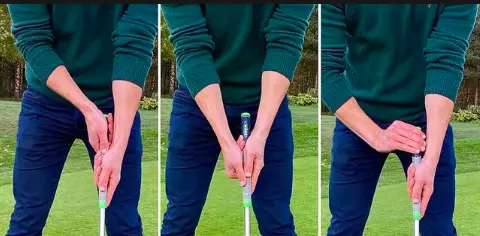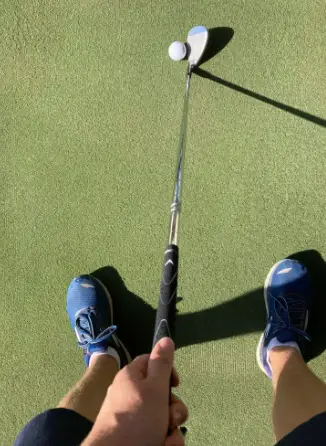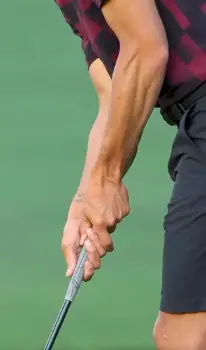Frankly speaking, golf demands mastery of various skills. Among these skills, putting is hailed as the pinnacle – the moment when the golfer's touch meets the ball's destiny.
What makes putting even more intriguing is the multitude of ways that golfers choose to grip their putters.
It is a fascinating realm of diversity, since each grip style offers outstanding advantages. So here is a quick tutorial on how to grip your putter in the proper way.
The claw grip: a touch of unconventionality

Picture a golfer addressing the ball on the green. You might expect to see a traditional grip, hands aligned, ready to make a pendulum-like stroke.
But in the case of the claw grip, that expectation is turned on its head. This grip, popularized about a quarter-century ago, redefines the norm.
In this unconventional technique, right-handed golfers position their right hand independently from the left.
The putter is cradled delicately between the thumb and forefinger, resembling a claw ready to grasp its prey.
This distinctive grip intentionally renders the right hand more passive during the stroke. The claw grip is a testament to the creativity golfers employ to find consistency on the putting surface.
The left-hand low grip: a southpaw's advantage

Now, let's consider the left-hand low grip, a widely adopted nontraditional approach for right-handed golfers.
This grip flips the script, placing the left hand below the right, assuming a commanding role in controlling the putter's path.
Interestingly, even natural left-handers like Jordan Spieth opt for this grip when playing golf right-handed.
By positioning the left hand low, golfers harness the power of their non-dominant hand to steer the putter head.
It's a testament to the versatility of putting grips, where one's dominant hand takes a back seat to enhance precision.
Two thumbs: the symmetry seeker's choice

Moving on, imagine a golfer with their palms facing each other, both thumbs resting on the top of the putter shaft, and index fingers placed along opposing sides of the putter.
This grip is known for creating symmetry, allowing the hands to hang naturally straight down, unlike the conventional grip where one hand typically rests above the other.
This technique is often referred to as the prayer grip. It helps maintain level shoulders, facilitating a pendulum-like putting motion.
It's a testament to the quest for perfection in golf that golfers continually experiment with unique grips to find their optimal stroke.
The reverse overlap: a time-tested classic

Now, let's pivot to the second article, where we encounter the concept of the reverse overlap grip. This grip style, perhaps the most prevalent among golfers, thrives on familiarity and simplicity.
The reverse overlap grip is a natural choice for many because it limits excessive hand manipulation during the stroke.
It mirrors grips used in sports like baseball, hockey, and cricket, where the dominant hand often sits lower for increased control.
Golfers who choose this grip are in good company, as legends like Tiger Woods, Rory McIlroy, and Dustin Johnson employ it to great effect on the PGA Tour.
Left hand low or cross handed: the unconventional challenger
On the other hand, the left-hand low or cross-handed grip offers an intriguing alternative. It's celebrated for its ability to prevent the left wrist (or lead wrist) from breaking down during the putting stroke.
The likes of Arnold Palmer and Jack Nicklaus have championed this style, leaving us to ponder its potential advantages.
To adopt the cross-handed grip, golfers place their left hand on the putter similarly to the reverse overlap, but further down the grip.
The right hand then joins in, with variations depending on comfort. This grip emphasizes the alignment of elbows and forearms, leading to a putting motion powered by the gentle rocking of the shoulders.
Pick your putter grip and make the ultimate decision
Thus, since we've reviewed the world of putting grips a little bit, the inevitable question arises: which grip style is superior?
The answer, like many things in golf, isn't definitive. The reverse overlap grip, with its familiarity and the support of countless professional golfers, remains a solid choice.
It's a grip that aligns with other sports and transitions smoothly from the full swing grip with minimal adjustments.
For many, it's the most natural and dependable choice. On the flip side, the left-hand low or cross-handed grip presents a unique challenge to the status quo.
It offers advantages in wrist stability and has garnered praise from golf legends. With more professionals embracing this grip, it's definitely a compelling option to explore.
As golfers, we navigate through a sea of options, each grip style offering its unique set of advantages and challenges.
What works best for one golfer may not suit another, making the quest for the perfect putting grip a highly individualized pursuit.

Enrique Martínez Luque
Enrique Martínez Luque is the Argentina-based golf expert and professional writer. He built his career in the world of golf taking a number of positions. Enrique was the manager of a golf club, director at a federation level, an agent for professional golfers and director institutional relations on the Argentinian Tour. Assissted the professional golfers on major tours for almost 20 years. Worked as the press officer of national and international golf tournaments.
Follow me


